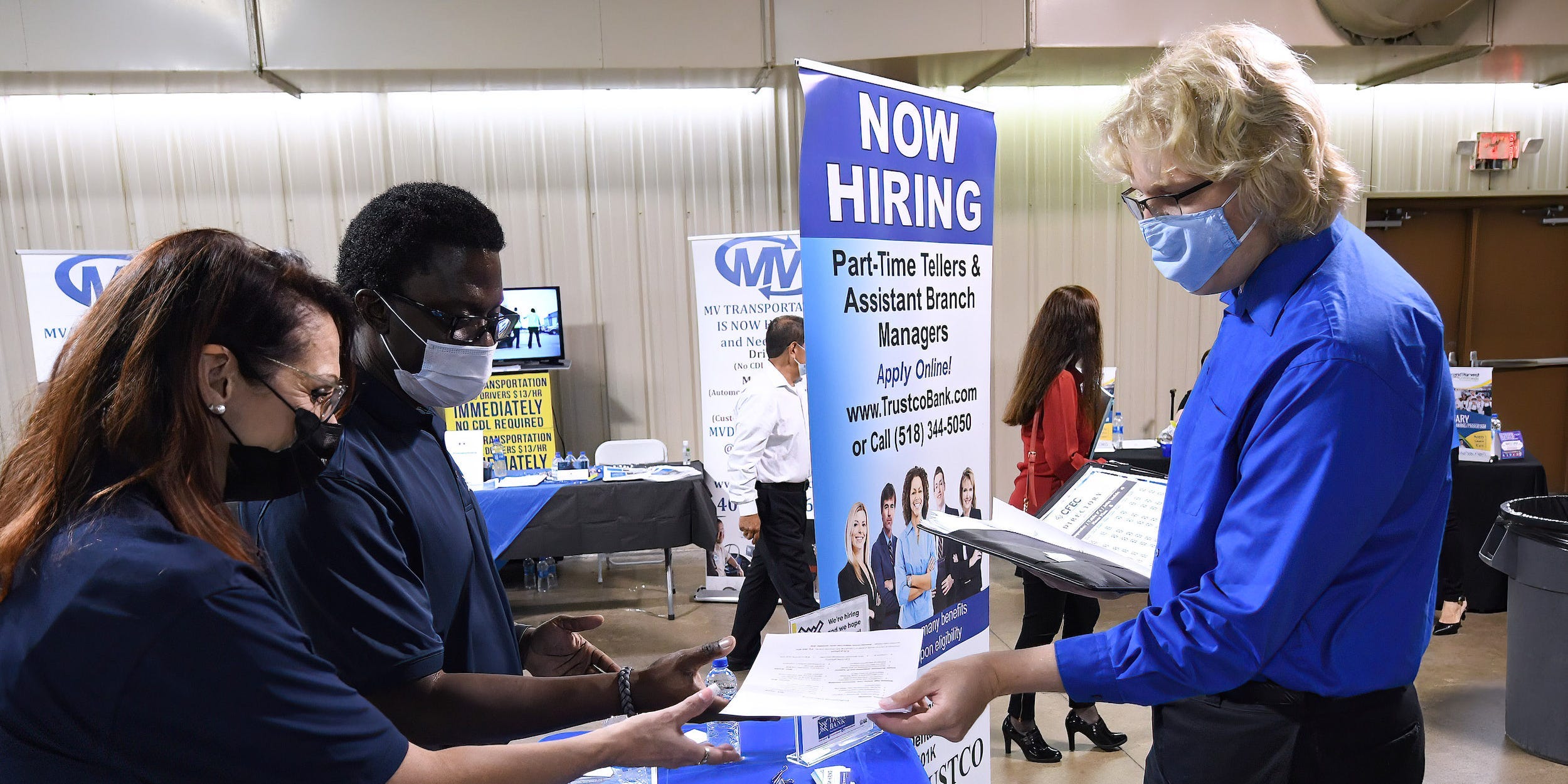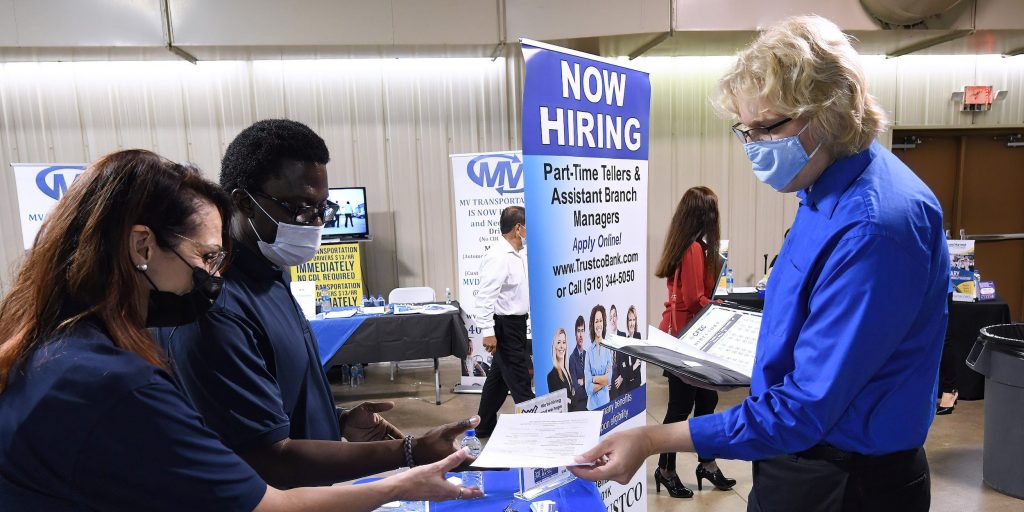
- The US economy gained 559,000 jobs in May, falling just short of the median estimate of 674,000 payrolls.
- The unemployment rate dipped to 5.8% from 6.1%. Economists expected a drop to 5.9%.
- The data marks a fifth straight month of job additions and a strong acceleration from April.
- See more stories on Insider's business page.
After a hugely disappointing April report, the US labor market's recovery seems to be back on track, albeit not quite to the degree economists hoped.
The US economy added 559,000 nonfarm payrolls in May, the Bureau of Labor Statistics said Friday morning. Economists surveyed by Bloomberg held a median estimate of a 674,000-payroll gain. The reading shows a sharp acceleration from April's dismal report, which saw job growth land well below economist forecasts.
The May increase marks a fifth straight month of job additions. The April payrolls count was revised to 278,000 from 266,000.
The unemployment rate fell to 5.8% from 6.1%. That came in below the median forecast for a decline to 5.9%.
The U-6 unemployment rate – which counts Americans marginally attached to the workforce and those working part-time for economic reasons – dropped to 9.7% on an unadjusted basis from 9.9%.
It's hard to love or hate the report, Nick Bunker, economic research director at Indeed, said. The rebound from April is a welcome sign, but further acceleration is needed to bring about a swift recovery.
"Adding over a half-million jobs in one month is a solid pace of growth, but we will need to keep up this tempo for quite some time to get back to a semblance of the pre-pandemic labor market," Bunker said.
The labor-force participation rate dipped to 61.6% from 61.7%. The gauge has taken on new relevance through the pandemic as millions of Americans sit on the sidelines after leaving the workforce.
The measure also gives insight into the labor-shortage phenomenon that first emerged in April. Businesses reported difficulty finding skilled workers, particularly in low-paying service industries. The previous jobs report showed wages climbing at a faster-than-usual rate, signaling companies were paying up to attract workers.
Various factors have been linked to the market tightness. Virus fears could be keeping some from seeking work, as nearly half of all Americans still aren't vaccinated against COVID-19. Childcare costs and schools' summer breaks could also be keeping parents from their jobs.
The small drop in labor participation and steady climb in wages backs up claims of a worker shortage, Seema Shah, chief strategist at Principal Global Investors, said.
"With unemployment benefits set to fade in the fall, we may be waiting until the end of summer before we see clear evidence of a fundamentally healing labor market," she added.
Diving deeper into the report
The government's monthly payrolls report is already among the most closely watched economic indicators, but April's shocking print only added to the Friday release's relevance. Apart from the headline figures, the report includes several other gauges that further detail the pandemic-era labor market.
Despite the payroll gains, roughly 9.3 million Americans remain unemployed. Job growth is expected to come in strong over the next few months as the economy reopens further and businesses rehire. Still, the sum of jobs lost to the pandemic places a full recovery well into the future.
The leisure and hospitality and education and health services sectors added the most jobs, with gains of 292,000 and 87,000 payrolls, respectively. The retail sector shed the most payrolls with a decline of 5,800.
Roughly 2.5 people said COVID-19 was the main reason they didn't seek work throughout last month. That's down from 2.8 million in April.
About 7.9 Americans cited the pandemic as the top reason why their employer closed down. That compares to the previous month's reading of 9.4 million.
The number of people classifying their unemployment as temporary fell to 1.8 million from 2.1 million. That compares to a pandemic-era high of 18 million and the pre-crisis low of roughly 700,000 Americans.
Roughly 16.6% of working Americans telecommuted through May because of the pandemic. That's down from 18.3% in April.
Early UI cancellation and the looming fiscal cliff
The latest jobs data comes as states split over how to proceed with their labor-market recoveries.
Within hours of the April jobs report's release, Republican lawmakers blamed enhanced unemployment insurance for the hiring shortfall. Half of all US states are set to end the $300-per-week federal benefit before its planned expiration in September. The move - carried out by GOP-led states - is estimated to cut UI payments for roughly 4 million Americans.
Yet UBS economists in May said school closures and virus worries probably had a bigger impact on keeping Americans from work than UI. JPMorgan pegged the early cancellation "to politics, not economics," adding that many participating states are still far from complete recoveries.
The early cancellations pull forward part of what economists have referred to as a "fiscal cliff" on the horizon. A slew of relief programs, ranging from the federal UI boost to the freeze of student loan payments, is set to end in the fall. The expirations will reinstate some financial burdens not instituted since early 2020, and some economists have raised concerns around how such a sudden return to pre-pandemic norms could affect the recovery.
For now, at least, other indicators are flashing encouraging signs. Weekly jobless claims continue to steadily decline, most recently sinking below 400,000 for the first time since March 2020. Weekly UI filings have now hit five consecutive pandemic-era lows, suggesting that continued vaccination and reopening are cutting down on layoffs.
Experts are also fairly optimistic in their views of the labor shortage. The phenomenon should fade by the fall as the new school year begins and more Americans are vaccinated, Fed Governor Lael Brainard said in a Tuesday speech.
"The supply-demand mismatches in the labor market are likely to be temporary, and I expect to see further progress on employment in coming months," she said.
